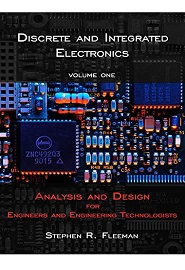
English | 2019 | 414 Pages | PDF | 14 MB
Discrete and Integrated Electronics (Volume 1 of 3) is a textbook that was written to help anyone who is interested in learning the basic concepts in electronics which lead to the analysis and design of electronic circuits. A background in DC circuits is assumed. Basic algebra with a hint of plane trigonometry is used.
Illustrations rather than complex mathematics help you grasp every concept. Narrated examples to help you understand the whys and not just the hows. Latest technology like the organic semiconductors used to make OLED televisions and displays is included. Practical examples like operation and design of a DC power supply is explained and illustrated by leading you through the process step by step. This includes using manufacturers data sheets.
An inexpensive software program (purchased separately) called NI Multisim is used throughout. It allows you to draw an electrical schematic diagram and simulate the circuit operation. Its use is explained with many screen captures. NI Multisim is used extensively in industry and academia. In Discrete and Integrated Electronics, it is employed to show via simulation the accuracy of our approximations and allows us to predict the behavior of electronic circuits.
Six chapters are included in this volume: Chapter 1 – Solid-State Physics and the P-N Junction, Chapter 2 – Diodes and Circuit Analysis, Chapter 3 – Diode Applications and Additional Devices, Chapter 4 – DC Power Supplies: Rectification and Filtering, Chapter 5 – Bipolar Junction Transistors, and Chapter 6 – Field-Effect Transistors.
Chapter 1 provides a qualitative (no math) description of semiconductors. Chapter 2 explains the operation of diodes and their equivalent circuits. Rectifier diodes and zener diodes are included. Chapter 3 shows application circuits to protect electronic systems from excessive input voltage and reverse polarity protection when batteries are used. Additional devices like light-emitting diodes (red, green, blue, infrared, and laser), photoconductive cells, pin photodiodes and solar modules. Chapter 4 is described above. Chapter 5 describes the theory underlying the bipolar junction transistor (BJT) and its use as an amplifier or a switch. Switch operation is demonstrated using a small toy robot called “The Clapper”. Chapter 6 describes the junction field-effect transistor (JFET), the metal-oxide semiconductor field effect transistors (MOSFETs), and the insulated-gate bipolar transistor (IGBT). Amplification and switching are explained. Switching is demonstrated using a power on/off switch incorporating a MOSFET and BJTs.
The circuits are operational in almost every case. The author has taught at the university/college level for 35 years and worked as an electrical engineer in aerospace for 31 years concurrently.
Resolve the captcha to access the links!